Closing the Distance:
Improving Terminal Passenger Mobility and Journey Times
Written by: Andy Lee, Jordan Roos and Karst Smit with contributions by Richard Barone, Lisa Schafer and Matt Lee
Over a half-century ago, the air passenger experience was quite different from what we see today. With commercial aviation still in its infancy, the Golden Age of flying was a time of luxury, glamour and style. The aircraft of that era were smaller and airfares were much higher. Passenger clearance procedures were simple and terminals were often single buildings designed to allow passengers to walk a short distance straight out to the airfield after being dropped off at the curb. In the ensuing years, airline Hubs were established as the industry responded to regulatory changes that required the development of these more complex facilities. In recent years, terminals have been transformed into lifestyle complexes with restaurants, shops and other amenities to occupy customers as they wait to board their flights. Consequently, the walking distance from curb to gate has grown, creating new mobility challenges that airports are only now beginning to address.
The Reasons Why Curb to Gate
Walking Distances Have Increased
There are several factors that have led to the extensive curb to gate distances experienced by passengers in modern terminals. They include airline deregulation, post-911 security screening, and evolving aircraft dimensions and fleet mix.
Airline Deregulation and Rise of Hubs
The United States Airline Deregulation Act of 1978 allowed airlines to shift their business models from the traditional point-to-point networks serving Origin & Destination (O&D) passengers, to the hub-and-spoke networks connecting passengers through their principal airports. Hubs allow airlines to make routes with low O&D passenger volumes viable, by filling up the remaining seats with connecting passengers, and the establishment of hub airports soon spread around the globe. Examples of successful Hub airports are Hartsfield-Jackson Atlanta International Airport (ATL), Dallas/Fort Worth Airport (DFW), Chicago O’Hare Airport (ORD), Frankfurt Airport (FRA), Dubai Inter-national Airport (DXB) and Singapore Changi Airport (SIN), to name a few. While airlines adapted their business model from being a point-to-point carrier to being a hub-carrier, so had their airports to accommodate this new type of passengers and their needs, which included:
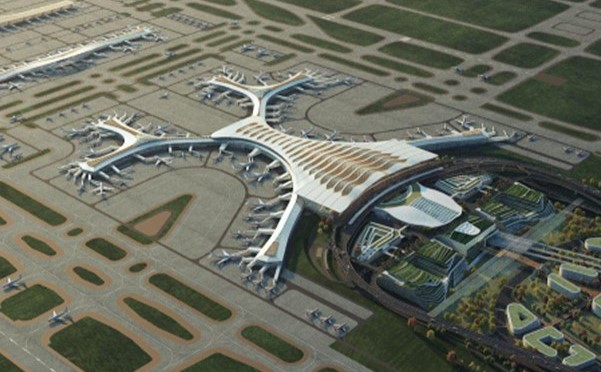
Source: Kunming Changshui International Airport
- Being Responsive to Schedules and Network Structures – O&D airports tend to have more sporadic flight schedules; whereas, hub airports typically have multiple arrival and departure banks per day. This results in flights from different destinations arriving at similar times, to then feed departing flights. These banks are essential for a good functioning hub as they combine regional, domestic, and international flights and create a more ideal connecting opportunity. This MCT plays an important role in maintaining the airline’s schedule.
- The Ability to Serve Peak Periods Passengers and Aircraft Facilitation – The bank schedules require hub airports to accommodate more passengers and aircraft on the ground simultaneously. The airports, therefore, tend to get bigger to be equipped with more passenger processing (e.g., re-check counters, Customs, Immigration and Quarantine [CIQ] and security) and gate capacities for these surges in demand, extending the travelling distances for O&D and transfer passengers alike.
A downside of the Hub typology is that a lot of this additional infrastructure is not used consistently throughout the day; whereas, if the same number of flights were spread out throughout the day, less infra-structure would be required. Additionally, these configurations often rely on automated people movers (APM) to assist in passenger movements. APM are typically expensive to build, operate and maintain (i.e., no or little capacity contingency), making them a major
“single point of failure” when airport traffic suddenly spikes. This issue has been noted at airports around the world such as (ATL), Denver International Airport (DEN) and Hong Kong International Airport (HKG), where APM are the main form of transportation linking the headhouse with landside connections to multiple midfield satellites/concourses.
Security Screening Requirements
Airport security measures became drastically more stringent and complicated after the events of 9/11 and have had a significant impact on the layout of the terminal and the passenger experience. The industry responded to the new passenger screening requirements positively, developing equipment to help expedite the screening process in less than a year. However, with the introduction of millimeter wave passenger scanners, CT bag scanners and empty tub return systems, security screening channels have gotten longer and wider inside the terminals. This has added to space requirements and the overall size of the facilities – leading to even longer walking distances from curb to gate.
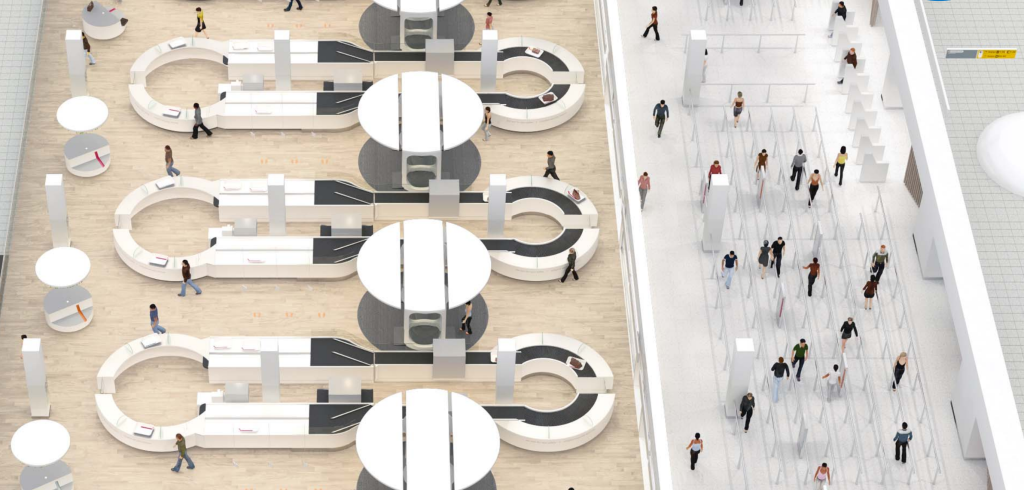
Source: ICAO; Schiphol Amsterdam Airport analysis
Evolving Aircraft Dimensions & Fleet Mix
Since the advent of the Jet Age over 60 years ago, the size of aircraft in each of the ICAO/FAA aircraft design groups have grown. For example, the current Boeing 737-10MAX is about 15 m/50 ft longer and 7 m/25 ft wider than the original (circa 1967) 737-100. Airports also now handle a higher proportion of widebody
aircraft to help overcome runway capacity constraints. This has had a major impact on the facility and airfield requirements and has also driven longer walking distances as terminal frontage and apron depth are stretched to facilitate these aircraft movements and expanded wingspans.
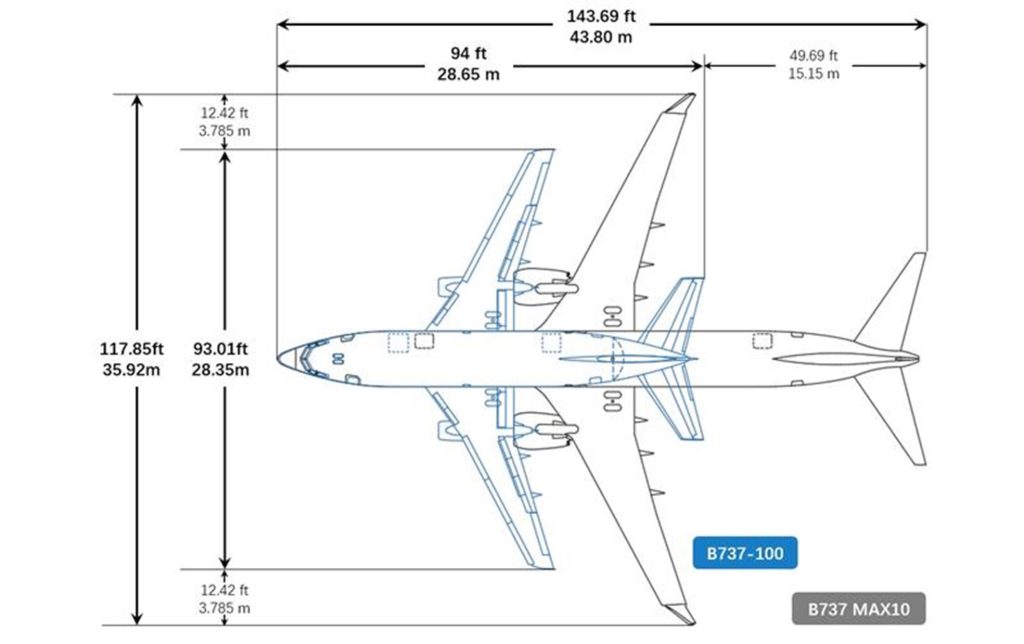
Source: Landrum & Brown
Case Study: CDG – The Evolution of An Airport
To meet various industry technological, regulatory and strategic changes, most airports have gone through several iterations of terminal builds, expansion/renovation and reconstruction. Over the decades, these changes have radically transformed their landside, terminal, and airside facilities. However, one European airport – Paris Charles de Gaulle Airport (CDG) – has maintained all the various terminal designs for all these eras, providing us with a real-world example of how terminal configurations, airfield-terminal-landside geometries, and passenger facilitation have evolved alongside industry changes. The airport opened in 1974 and today is one of the busiest airports in the world. The development of CDG’s nine separate terminal buildings/units can be put into two key periods, driven by principal carrier Air France’s strategic market positionings.
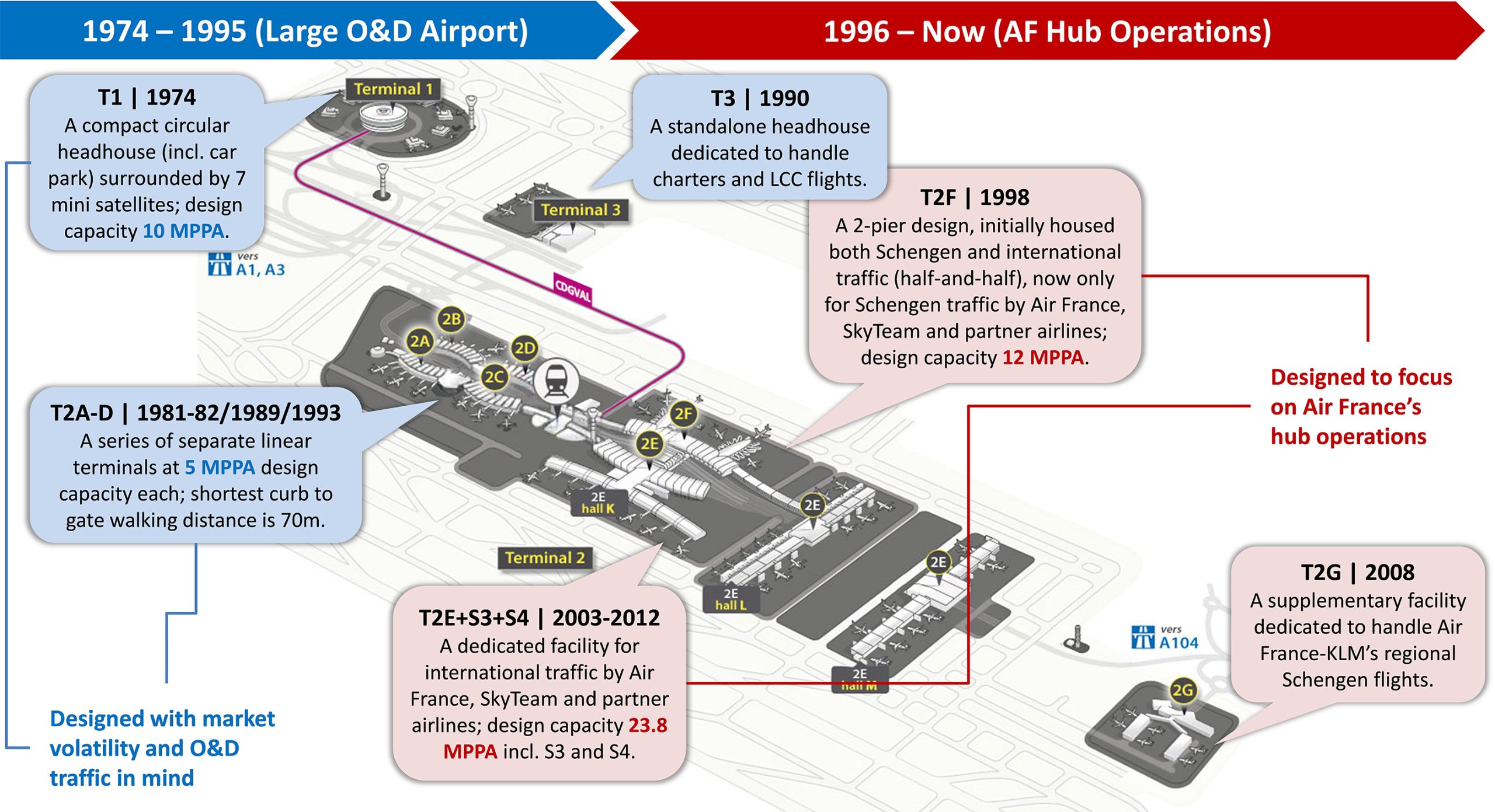
Source: Base map provided by Flightrader23.fr and illustrations by Landrum & Brown
CDG Estimated Passenger “Curb to Gate” Journey Distance by Terminal
| Curb to the furthest gate | T1 | T2A | T2B/C/D | T2E | T2F | T2G |
|---|---|---|---|---|---|---|
| Headhouse aided/unaided walk | 200 / 660 | 480 / 1,580 | 350 / 1,150 | 440 / 1,450 | 550 / 1,810 | – |
| Airside walkway(s) | 130 / 430 | – | – | – | – | – |
| Airside APM | – | – | – | 930 / 3,050 | – | – |
| Satellite aided/unaided walk | 70 / 230 | – | – | 390 / 1,280 | – | – |
| Total Distance | 400 / 1,320 | 480 / 1,580 | 350 / 1,150 | 1,760 / 5,780 | 550 / 1,810 | 320 / 1,050 |
NOTE: “Aided walk” meaning via moving walkway(s), escalator(s) and/or elevators. Source: Landrum & Brown analysis
A Large O&D Airport
Terminal 1 at CDG was the first facility built at the airport when it opened in the 1970’s, when the airline market was still heavily O&D focused. The facility works well for O&D passengers, as the compact circular headhouse (less than 200 m / 660 ft in diameter) is connected to seven mini satellites via some 130 m/430 ft long underground walkways, maintaining a balance of short walking distances from cars to/from aircraft but a 10MAP (Million Annual Passengers) handling capacity. CDG’s initial master plan (as shown below) anticipated five of these terminal clusters, but that was later abandoned due to evolving aircraft technologies and the effects of the first and second oil crises throughout 1970/80s.
Terminals 2A-D – planned and constructed during the 1980/90s – took a similar design approach with the O&D passengers largely in mind. The terminal complex features four shallow processors with six contact stands each, this module design keeps the terminal units user-friendly (approx. 70 m / 230 ft from curb to gate) and flexible to implement. Notably, this compact terminal depth is likely dictated by the car parking facilities now standalone structures driven by further mass motorization on landside.
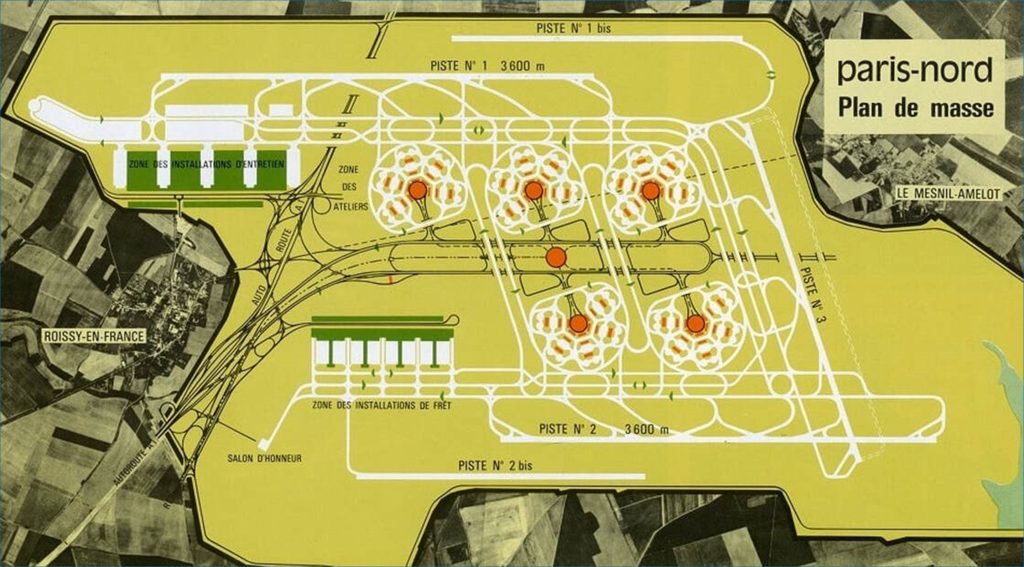
Source: Groupe ADP via Airporthistory.org Source: Landrum & Brown analysis
Air France Hub Operations
When Air France started to develop its hub at CDG, new Terminals 2E/F were built to better suit the requirements of the new hub operations. The focus shifted from minimizing the walking distances from curb-to-gate to gate-to-gate inside the terminals (including the introduction of decentralized security screening in Terminal 2E), along with providing larger ramp and airfield spaces to maximize aircraft turnaround efficiency. As headhouses became larger and airside satellites more prominent, O&D passengers’ average journey time was extended. The result was that the newer CDG terminals did not provide as good of an O&D experience as their predecessors.
As illustrated by the example of CDG, airport terminal design is a collective consideration of competing criteria and parameters, the result is typically based on a predetermined set of priorities. What works best from an airfield perspective for aircraft operations is not always the best terminal configuration for passengers; and what is good for transfer passengers does not necessarily result in the best experience for O&D passengers.
Identifying Solutions to “Close the Distance”
There are several industry bodies that have attempted to address the issue of increasing walking distances, specifying guidance to mitigate these increasing distances when designing/evaluating terminal concepts, these include:
- International Air Transport Association (IATA), Airport Development Reference Manual (Edition 12) Any walking distance in excess of 300 meters (approx. 984 ft) should be provided with moving walkways that reduce unaided walking distances.
- Transport Research Board (TRB), ACRP Report 25: Airport Passenger Terminal Planning and Design (Volume 1: Guidebook)
An industry rule of thumb concerning maximum walking distance has been that, if the distance travelled exceeds 1,000 feet (approx. 305 m), then some sort of mechanical people-mover assistance should be added. - Civil Aviation Authority China (CAAC), Airport Master Plan Technical Indicators (Trial Version) At least 80% of the terminal contact stands should fall within 600 meters (approx. 1,969 ft) of walking distance post security screening points
In addition, to implementing industry guidelines to help mitigate terminal walking distances, terminal planners have been formulating new strategies and designs to meet today’s planning and operational realities and changing conditions. Some existing and upcoming solutions in response to these are identified in the following table.
Potential Solutions to Help “Close the Distance”
| In-town Check-in & Door-to-door Baggage Service | Curbside Baggage Robot | Elimination of Satellites/Remote Concourses | Direct Landside (Partial) Connections to Satellite(s) | Integration with Airside Vertiports – Advanced Air Mobility (AAM)) | |
|---|---|---|---|---|---|
| Solution Type | Eliminate bags during walks | Eliminate bags during walks | Reduce walking distances | Reduce walking distances | Reduce walking distances |
| Coverage | All pax types | >All pax types | All pax types | All pax types | CIPs/VIPs & Paid pax |
| Driving Force | Airport, airline, transport authority and/or private initiatives | Airport and/or airline initiatives | Airport and/or airline initiatives | Airport and/or transport authority initiatives | Airport, airline and/or private initiatives |
| Efforts to Implement | Medium to high | Medium to high | High | High | High |
| Investment Level | Medium to high | Medium to high | High | High | Medium to high |
Source: Landrum & Brown analysis
Remote Bag Drop/Pick Opportunities
While the focus of this Brief is on shortening passenger walking distances in terminals, our perception of a long walk is largely associated with how far we must drag our bags through these facilities, particularly prior to checking in or after baggage claims. To help enhance the passenger experience, airports have sought to provide opportunities to remove bags from passengers before or as they arrive at the airport. Although the concept of removing checked bags from passengers’ journey to/from the airport is not new, the technology and infrastructure has evolved over the recent years to make this service more viable than in the past. This includes express trains coupled with automated baggage handling system, utilizing logistics capabilities of metro (e.g. Shenzhen Bao’an Airport [SZX]) and convenience store to create remote bag drop/pick locations, and bag robots that can assist in the removal of passenger’s bags at almost any part the terminal on landside.
In addition to enhancing the passenger experience, the early removal of bags also enables new opportunities for terminals, including the integration of transit access at satellites and airside vertiports, both of which reduce the travel distance for the passenger.

Source: Shenzhen Government Online
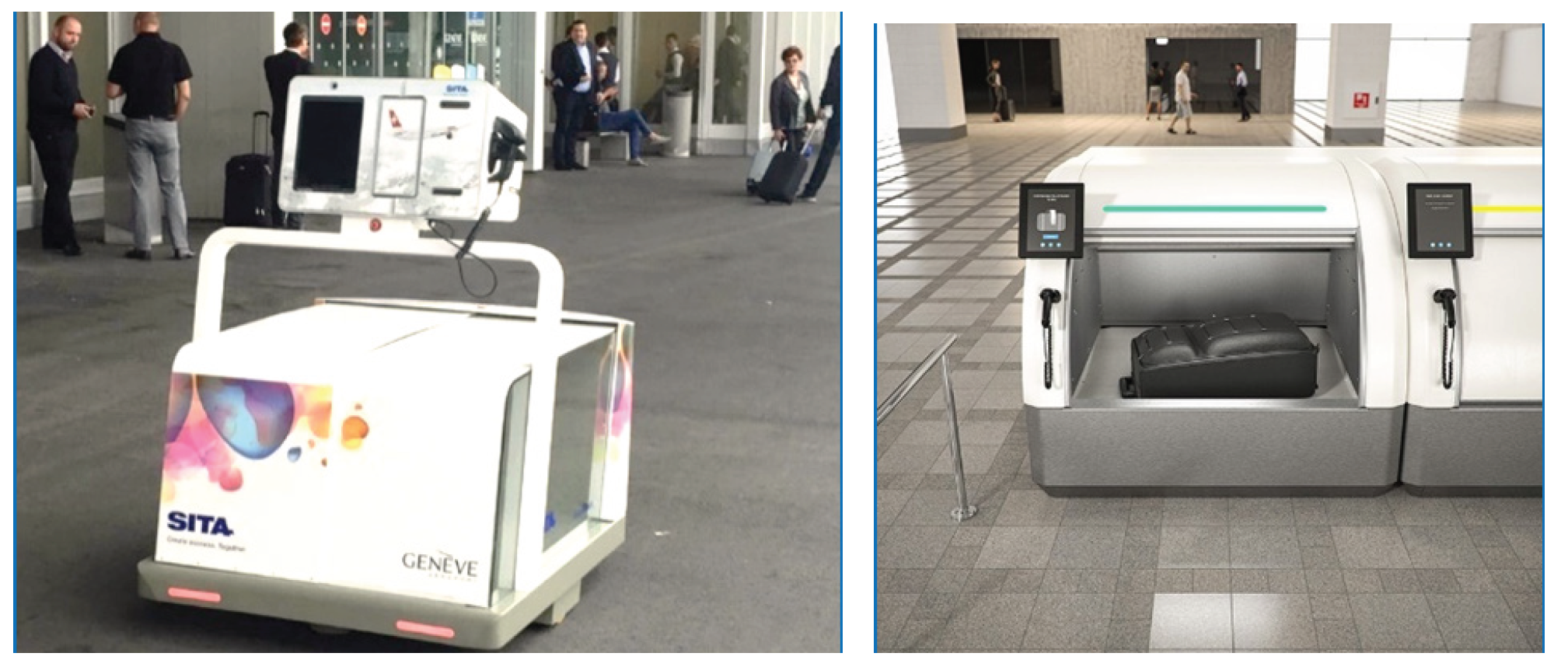
Source: SITA (left) and BEUMER Group (right)
Elimination of Satellites/Remote Concourses
The traditional definition of a satellite is an airside concourse that is surrounded by aircraft stands to allow the maximum gating of planes. Nevertheless, changing market conditions, passenger behaviours, and planning parameters are now being adopted that will redefine future terminal designs. For instance, after Pittsburgh Airport (PIT) lost its USAir hub in the early 2000s, the airport also opted to de-satellite its Midfield Terminal. When completed in 2025, its new headhouse – located in one of the four ramps of the formerly X-shaped satellite – would bring much needed relief to ticketing, security checkpoints, baggage claims and landside amenities for its O&D dominated traffic. This will also eliminate the old underground people movers and allow air passengers to walk straight to their gates instead, thus removing the ongoing operating expenses (OPEX) and future replacement costs for the people mover system.

Source: Allegheny County Airport Authority via YouTube.com
Direct Landside (Partial) Connections to Satellite(s)
Instead of reconfiguring their airfield and terminals, some airports are taking a different approach to reduce curb to gate walking distances, one mega-airport
in China is currently exploring the introduction of partial landside access to its future satellite. This is primarily made possible as rail ridership exceeded the ground transport mode share set out at the design phase, meaning more passengers are eligible to take advantage of the in-town terminal check-in and proceed directly to security and CIQ screening on site, with stations directly linked to these satellites.
For satellites that are equipped/designed with security (and CIQ) processing capability, this concept could become a reality if:
- Rail or landside people mover stations can be added, and
- In-town check-in and/or door-to-door baggage service can also be implemented.
This direct access would not only make satellite passengers’ journey more convenient, but also extend the lifespan of corresponding headhouse and its roadways, as a large portion of users can bypass these facilities altogether. This partial landside access could boost the overall terminal capacity (headhouse + satellite) by an extra 22% or 16MAP. This approach would maintain an airport’s midfield terminal configuration but also improve access for O&D customers.
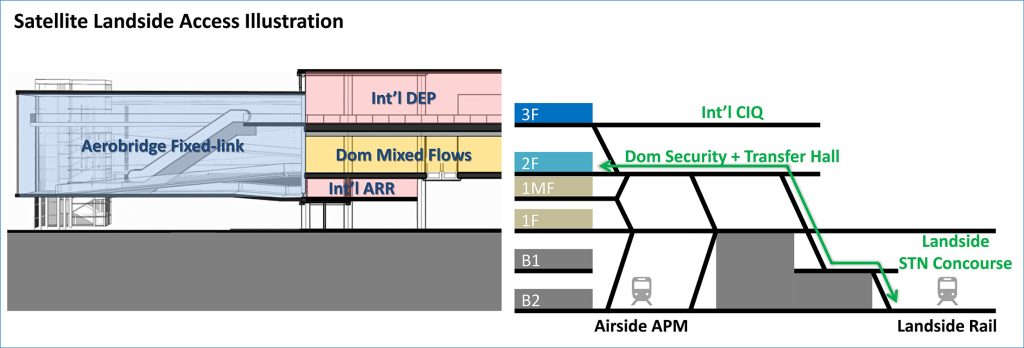
Source: Landrum & Brown
Integration with Airside Vertiports – Advanced Air Mobility (AAM)
As discussed in LAB briefs this past February and last year (Vol. 2 – Issue 5 and Vol. 3 – Issue 1), AAM is a nascent set of emerging vehicle types and service typologies that have the potential to shorten journeys for travelers. At airports, both landside and airside Vertiport sites are being contemplated for Urban Air Mobility services that will accommodate a variety of Vertical Take-Off and Landing (VTOL) vehicles. Airside Vertiports could be co-located within large midfield concourses if the recommended distances from active runways met and conflicts with various surfaces be ameliorated.
With direct tie-in to urban centers this solution could provide air passengers with an expedited connection to the airport with opportunities to bypass major pain points within the airport from parking/curbside to security. This could be combined with in-town baggage check and security screening before passengers boarded the VOTL to the airports. Several air carriers are exploring the viability of this type of service.
FAA Recommended Distance from Vertiport Approach to Runway Approach by Airplane Type
| Airplane Type | Airplane Size (lbs / kgs) |
Recommended Separation Distances (ft/m) |
|---|---|---|
| Small | =< 12,500 lbs =< 5,670 kgs |
300 ft / 91 m |
| Large | 12,500 – 300,000 lbs 5,670 – 136,078 kgs |
500 ft / 152 m |
| Heavy | > 300,000 lbs > 136,078 kgs |
700 ft / 213 m |
Source: FAA – Engineering Brief No. 105, Vertiport Design
Differences in Vertiport Site Locations On-Airport
| Airside vertiport challenges and opportunities | Challenges | Opportunities |
|---|---|---|
| Inbound |
|
|
| Outbound |
|
|
| Landside vertiport challenges and opportunities | Challenges | Opportunities |
| Inbound |
|
|
| Outbound |
|
|
Source: Landrum & Brown Analysis
While this is an emerging mode of transportation that is still under development with technological, operational and regulatory issues to still be worked out, airports should be to explore the integration of vertiports in their facilities, so they are better prepared to engage with airlines and other emerging UAM service providers.
Airport terminal typologies have evolved over the decades to respond to market, regulatory and technological developments. Besides the evolution of aircraft dimensions, the two biggest events, deregulation and 9/11, led to a complete reconfiguration of our larger commercial airports – they were first reoriented from serving O&D passengers to Hubs for transferring/connecting air travelers and then reconfigured (and expanded) to provide an extensive security screenings post-9/11. While all these changes were occurred to respond real demands, lost in the rush to respond to these challenges was the impact on the mobility of air travelers. This does not only include the cavernous gap between the curb and gate for O&D passengers but even between the gates themselves for those connecting.
Airports need to start closing the distance between the gates and the landside and rescaling their facilities to supporting greater accessibility to lessen the impact on overall passenger mobility and journey times. As the number of elderly air travelers continues to expand, solutions that lessen the burden such as in-town baggage check, direct access to satellite concourses and emerging modes such as AAM, will be a means of making airports far more accessible to all travelers.
What is the L&B LAB?
The LAB is Landrum & Brown’s research and development unit. Our mission is to harness decades worth of industry knowledge and expertise to develop innovative solutions that support our clients along with promoting industry thought leadership.
This document was prepared by Landrum & Brown, Inc. | [email protected]
Sign up to receive our next L&B LAB in your inbox!






